Last time, I discussed what I perceive as a problem in the way that most open world games (specifically, sandbox games) design their maps and use the space that the maps offer - or fail to use that space, to be more specific. So many open world maps end up feeling less like actually playing the game, and more like a convoluted mission-select and collectible checklist screens. This problem is especially bad in the Ubisoft model of design, and is also a problem (to a lesser extent) in Bethesda's open worlds. Due to the popularity of these developers' franchises, many other developers have been cloning these styles of games to one extent or the other, to the point at which Ubisoft's open world model seems to be the go-to template for any developer trying to make an open world game. These games aren't necessarily bad. They just aren't very good at making the space of their maps feel meaningful in its own right.
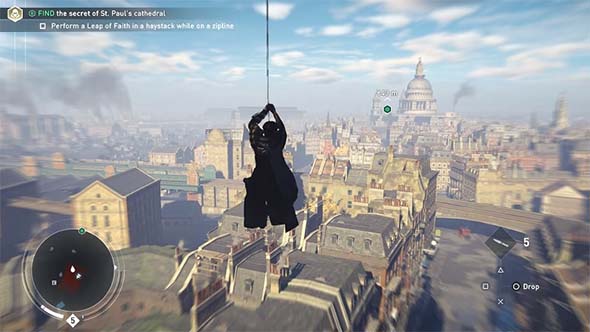
Many open world games have large, expansive maps that mostly feel empty and pointless,
as the player rushes through them simply to get to the next map marker or checklist item.
But now that I've established what I see as a problem, I want to focus on positive feedback. In this discussion, I'm going to look at a handful of games that should serve as inspirations for would-be open world developers. Ironically, some of these games aren't even open world games, but they still pose valuable lessons for how games that are open world could better use their game spaces. That isn't to say that the games discussed here are perfect. In fact, many of them have their own major flaws. But each of them has some element of design that utilizes the actual game map as a component of active play, rather than just a space in which game sequences exist. First, let's take a look at a game that was re-made recently, and use it as a "before and after" case study of map design... [More]
75d0658b-0278-43f3-a9e5-d3df3d01939d|4|4.3
Tags:open world, map, traversal, travel, cartography, geography, narrative, ludonarrative, ludonarrative dissonance, quest, vehicle, driving, racing, exploration, wasteland, survival, resources, Ubisoft, Bethesda, Resident Evil, Metal Gear Solid V: the Phantom Pain, Assassin's Creed, The Elder Scrolls, Skyrim, The Witcher 3, Grand Theft Auto, Grand Theft Auto V, Grand Theft Auto: San Andreas, Shadow of Mordor, Fallout, Fallout: New Vegas, Wasteland 2, Mad Max, Miasmata, Assassin's Creed IV: Black Flag, Burnout: Paradise, Shadow of the Colossus, Dark Souls
I wrote a lengthy blog late last year about the stagnant, "limbo"-like feel of most open world games' narratives. I had written that blog mostly before I played Metal Gear Solid V, and so I wasn't able to incorporate my thoughts regarding that game into the blog. But I did come to a new realization about open world gaming while I was playing MGSV. In my review of that game, I noted that:
"Even the open world itself feels constrained, as sheer cliffs prevent you from travelling too far off of the roads and serve to functionally railroad the player towards the small set-piece outposts and villages."
- from my Metal Gear Solid V: the Phantom Pain review
I realized while playing MGSV that the game had built this large, open world (well, two large, open worlds really, but I hadn't gotten that far yet), but it didn't really care to let the player actually traverse that space or use it in any meaningful way other than scavenger hunting for collectibles. At least those collectibles felt relevant to gameplay though! Roughly half the map is dead space that the player can't even access. There was also this strange focus on using the helicopter to drop in and drop out of missions, rather than actually living in the game world, as the character had to do in Snake Eater. The map started to feel less and less like a place, and more like a convoluted mission-select screen. At first, this seemed like a strange, isolated example of an open world game that really doesn't want the player actually exploring its world. But as I thought about it, I realized that this isn't really a new phenomenon; it's actually just a very extreme example of what has become a sort of defacto state in most open world games.
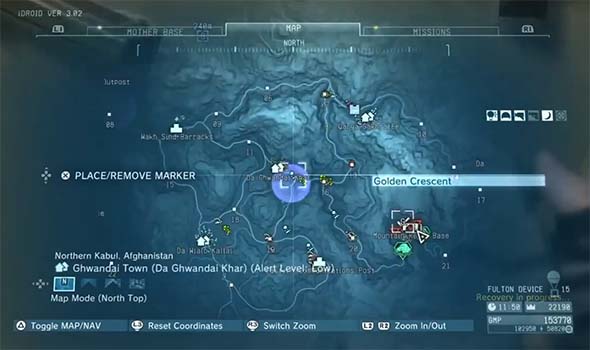
The Afghanistan map of Metal Gear Solid V feels heavily constrained by sheer cliffs.
Think about it this way: in a linear game with rooms and corridors, every hallway and room should serve some purpose or function. In most games, this function will be some kind of skill or system mastery test. An action game like Devil May Cry will throw enemies at you to fight; a puzzle game like Portal will have a puzzle (or a piece of a puzzle) in the room to solve; a stealth game like Metal Gear Solid 3 will have a sneaking challenge or obstacle to pass; and so on. In the best games, each of these challenges will also provide a unique or novel test of skill or system mastery: unique combinations of enemies, unique puzzles, or novel arrangements of enemies and obstacles. Other games can use those rooms for thematic or narrative purposes. A survival horror game like Resident Evil or Silent Hill will usually put enemies, puzzle items, or supplies in a room, but some rooms might instead contain a scripted scare. In some cases, a room might even be left completely empty in order to build some kind of tension or anticipation, or to delay the release of already-built tension or anticipation.
So what is the gameplay purpose of an open world map? ... [More]
d6e62cdb-b171-437a-b1a7-107859c9c818|4|4.5
Tags:open world, sandbox, game design, map, paradox, traversal, travel, cartography, geography, narrative, ludonarrative, ludonarrative dissonance, quest, exploration, driving, racing, vehicle, Ubisoft, Bethesda, Beenox, Metal Gear Solid V: the Phantom Pain, Assassin's Creed, the Amazing Spider-Man, Spider-Man, web-swinging, The Elder Scrolls, Skyrim, The Witcher 3, Fallout, Mad Max, Far Cry
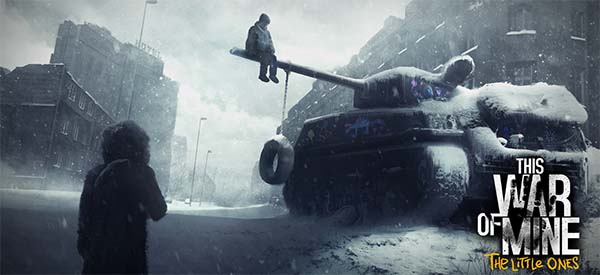
It was a long wait to get this DLC on PC and Steam. It originally released back in January on consoles, while we early adopters of the PC version were stuck waiting out in the cold with no clue whether or not we'd ever get the expansion. I wanted to play it, but I was hoping that a PC version would be released because I was skeptical that controlling a shelter full of characters with only an analog stick (and no pause button) would be unweildy. But it finally did get a release on Steam, and was even discounted during the Steam Summer Sale, so there was no way that I was going to pass that up.
The base version of This War of Mine is a fantastic game and ranks up there with Papers, Please, Metal Gear Solid 3, and Ace Combat 4 as one of the best games about war that I've ever played. This War of Mine is a very harsh, brutal, and depressing game. But if you didn't think that it was a depressing enough game to begin with, then wait till you play it with children as playable characters! The expansion adds some new scenarios with child characters as well as a handful of child-specific craftable items, but it's surprisingly skimpy on new content. As far as I can tell, there are no new scavenge locations, ambient events, or neighbor events.
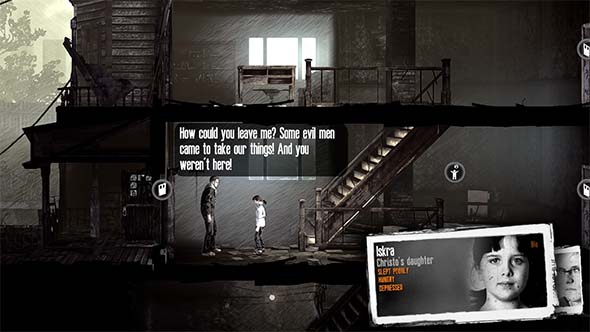
If the game wasn't already difficult and depressing enough, now you have to keep children safe as well.
The trauma of war
Children can be both a burden and a blessing in this game. By default, they can't perform most crafting, they can't shovel away rubble or unlock blocked doors, they can't be sent out to scavenge at night, and they can't do anything to guard or protect the shelter from raids. At the start, they are basically just extra mouths to feed that have the potential to consume more of your valuable medicines and bandages, but they can't contribute directly to your survival. They can also be particularly needy, and their needs can be tough to meet as you struggle just to get the basics like food, water, and an assembly line of crafting stations.
However, it won't stay like this for long, as children can be taught to do many of the same crafting tasks that the adults can do... [More]
7f046816-2d50-4dbe-8958-7c140325ddb6|0|.0
Tags:This War of Mine, This War of Mine: the Little Ones, expansion, DLC, PC, Steam, 11-bit studio, indie gaming, strategy, children, family, war, siege, refugee, civilian, survival, rogue
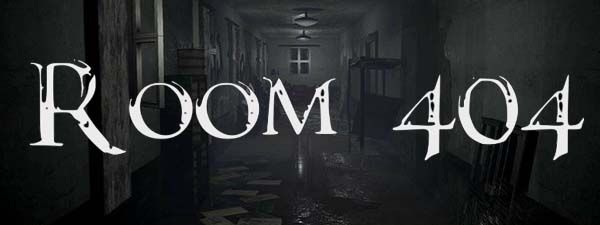
Since I'm in between major releases, it's time for yet another indie Steam game. This time, it'll be a game that was released this year! Only a few weeks ago, in fact! I picked up Room 404 (along with a couple handfuls of other games) in the Steam Summer Sale a couple weeks ago. It's yet another attempt to scratch that horror itch that was left behind by the cancellation of P.T.. Room 404 completely failed to scratch that itch.
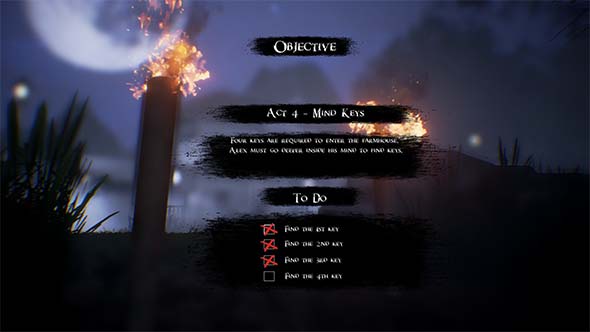
Practically the whole game consists of walking around collecting keys. Not very scary...
There's really not much to this game at all. It's only a couple hours long and isn't very mechanically or intellectually substantive. It falls firmly into the category of "walking simulator", and even that might be generous. There's basically three types of puzzles that get re-used throughout the game - if you can call them "puzzles", that is. All of them are resolved by simply exploring the linear areas to find the triggers to solve the puzzle. Numeric keypad locks are opened by searching adjoining hallways and rooms for the numbers that make up the combo, which are hidden in plain sight or in obvious locations. If you're not looking for keypad numbers, then you're looking for simple keys. The second puzzle type involves simply lighting candles in the right order. The final puzzle (which only appears once) puts you in a tiny maze and shows you a map that highlights your current location and the location of the exit. You turn three corners, and you're done.
Some of these puzzles are made a little bit confusing by the game's only real feature: its changing landscape. At several points in the game, you'll come across a locked door or obstacle, which will force you to turn around to find that your environment has changed. In some cases, this will mean that another door will suddenly be open, allowing you to explore a previously-closed off room. In other cases, you simply turn back around to find the obstacles gone. These situations are always accompanied by an audio cue to notify you that something has changed, and the sound of a creaking door will often notify you to go back and check previously-closed doors. In other cases, it's not always obvious what you're supposed to do, and I swear at least a couple puzzles were solved by my simply turning around in circles a couple times wondering what the heck the game wanted me to do.
Puzzles don't get any more complicated than finding keys and numbers hidden in plain sight.
There is an enemy in the game that can kill you on contact, just like in so many other "run and hide" horror games. However, in this case, you can't actually run or hide... [More]
30d421b7-c35e-4626-8f21-2b3bc34eef7d|0|.0
Tags:Room 404, 3DTM, Machine Bear Software, Steam, Steam Greenlight, psychological horror, horror, indie gaming, hotel, murder, father, son

Recently, I brainstormed the possibility of redesigning Beyond Earth's winstates in order to support cooperative victories. With Civilization VI having been announced last month, I want to take some time to look at some different ways to approach victories in the mainstream Civilization games. Since Civilization III, there have been five victory types that have appeared in every mainstream Civ game:
- the military victory = kill or conquer everyone else
- the science victory = build a space ship to Alpha Centauri
- the culture victory = accumulate the most culture yield (usually through wonders)
- the diplomatic victory = vote for yourself to be leader of the United Nations
- the score victory = if no other victories are met by a certain number of turns, the civ with the highest score wins.
Earlier games had fewer victories (only military and space race), but there have been other victory types as well. Civ III and IV had a victory that simply required the player to occupy a majority of the map's land area and population (which could be achieved via military conquest and/or relatively peaceful expansion). I liked this victory type because it facilitated role-play by allowing me to grow my empire organically without having to feel like I was constantly meta-gaming for one of the other victories - just keep growing by whatever means are necessary or convenient. Civ IV also had a religious victory that required you to convert other players to your religion and then get them to elect you to be Pope or whatever. Civ: Revolution and the board game even included an economic victory in which you must accumulate a certain amount of wealth tokens. This was different than the "economic victory" of Civ V, in which you save up enough money to buy out the alliance of every city state on the turn before a U.N. election.
Civilization IV included a religious victory [LEFT], and the board game includes an economic victory [RIGHT].
These victories are intended to provide a direct path to victory using each of the major fundamental gameplay styles. But are there other methods?... [More]
a7731900-5994-464b-bc32-bb3d6884e093|1|5.0
Tags:Sid Meier's Civilization, Civilization, Civilization V, Civilization VI, victory, military, science, culture, diplomacy, religion, high score, economy, peace, war, cooperation, humanism, humanist, alliance, ideology, space race, United Nations, world wonder, agenda, leaders, Theodore Roosevelt, board game, victory point, Ed Beach, Sean Bean, E3, Settlers of Catan, The Sims 2, Sid Meier's Civilization the Board Game
|

| 12 | | | | | | | 60 | | 11 | | | | | | | 55 | | 10 | | | | | | | 50 | | 09 | | | | | | | 45 | | 08 | | | | | | | 40 | | 07 | | | | | | | 35 | | 06 | | | | | | | 30 | | 05 | | | | | | | 25 | | 04 | | | | | | | 20 | | 03 | | | | | | | 15 | | 02 | | | | | | | 10 | | 01 | | | | | | | 05 |
|